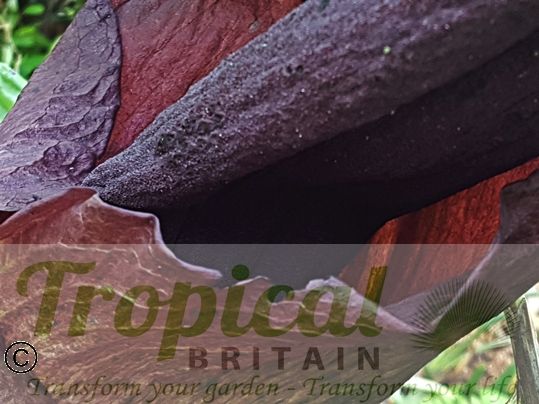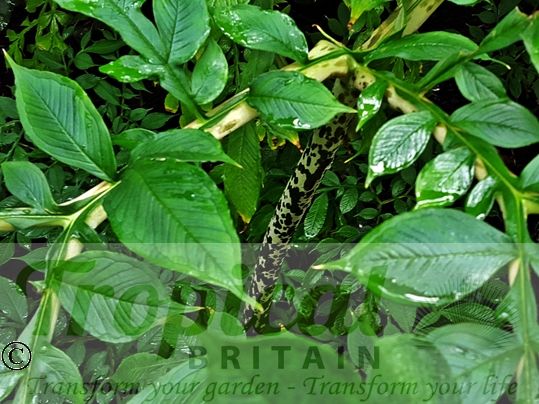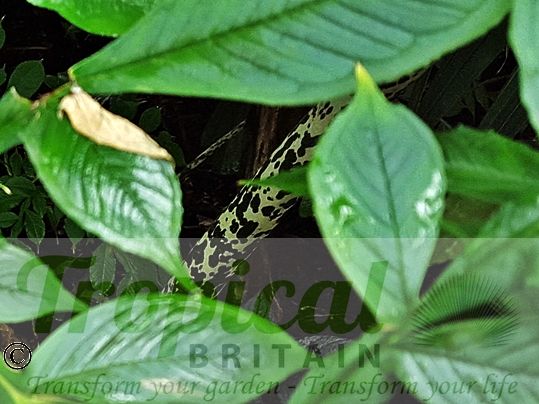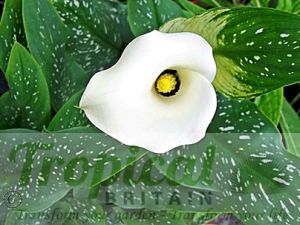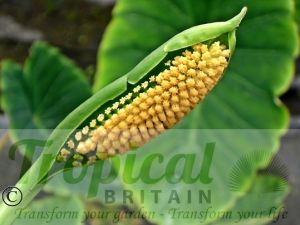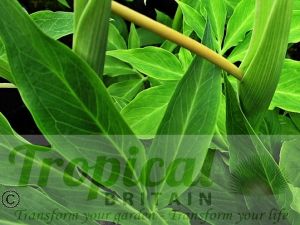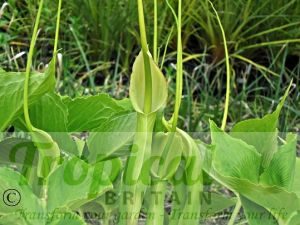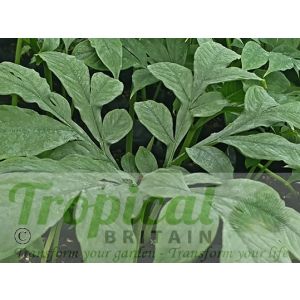Amorphophallus konjak is a native to the Orient and South East Asia. It is perhaps the easiest of all the Amorphophallus species for a temperate climate and it is probably the hardiest. Nonetheless, care is needed in its cultivation. It requires a well-drained substrate that is also rich with organic matter. The best way to achieve this is to surround the tuber in a bed of bark and sand that is then surrounded by the more fertile humus-rich soil.
On tubers that are large enough, the tall dark-maroon inflorescence arises, usually in Spring - before the foliage. It has a tall dark erect spadix and like most in the genus it has a strong fetid odour. The foliage emerges from its long dormancy in early summer and grows rapidly. The petiole is mottled with pale pink and grey or olive-green and brownish spots and is divided at the top to form the classic Amorphophallus structure resembling a complex umbrella from which the leaflets hang like leaves from the canopy of a tree.
Water and fertilise well during the summer and keep dry as the autumn develops. Most growers prefer to lift the tuber for winter to ensure they don't rot in the cold wet weather. When the foliage starts to die down in autumn it is best to leave the tubers alone until at least November or even longer to allow the new bulbils to develop. These are produced on the ends of long rhizomatous growths from the tuber. These long rhizomes eventually wither away to leave the new bulbils. This is usually the best time to lift them, although some tubers will usually have some of the rhizomes attached.
Sold as tubers during winter dormancy.
Additional Information
| Order | Alismatales |
|---|---|
| Family | Araceae |
| Sub-Family | Aroideae |
| Synonyms | Amorphophallus mairei, Amorphophallus nanus, Amorphophallus palmiformis, Amorphophallus rivierei, Brachyspatha konjac, Conophallus konjak, Conophallus konniaku, Hydrosme rivierei, Proteinophallus rivierei, Tapeinophallus rivierei |
| Geographical Origin | China, Japan, Korea, Vietnam, Thailand, Indonesia |
| Cultivation | Warm, sheltered position, ideally with high humidity. A humus-rich well-drained soil |
| Eventual Height | 80-100 cm |
| Eventual Spread | 60-80 cm |
| Hardiness | Cold tolerant. In moderate regions it can survive winter with a thick mulch and plenty of grit in the substrate. However, tubers are usually best dug up and stored over winter |
-
Quality plants and fantastic serviceMy Konjac arrived yesterday, only three days after ordering. It securely packaged and when unpacked it was in perfect condition, a good sized plant and even has side shoots coming through. I have since potted it on and am looking forward to seeing this beauty grow.
Tropical Britain have been spot on with any queries I had and their service has been second to none.Posted on
-
Can't wait for the springAll plants arrived very well packaged and I can't wait until next year to see this plant grow!
Posted on
-
SatisfactionI ordered this plant yesterday, and it arrived well packed, and labeled. it emerged in perfect condition,a strong sizeable plant ready to plant, and grow away.
Posted on

Free DELIVERY
ON ALL ORDERS OVER £99THIS OFFER IS VALID ON ALL OUR STORE ITEMS.

